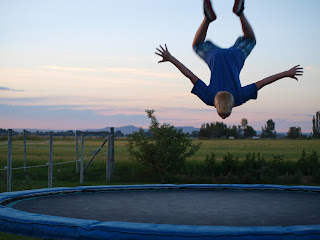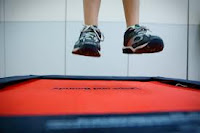Over the years having raised four daughters, we've had several lucky brushes when it came to injuries and broken bones. Now that they're all beyond the age of immediate concern, these comments may be helpful advice for parents with younger children. It’s all about trampoline use during this gift giving time of year…
 My good friend Michael Klein, M.D. is a longtime orthopedic
surgeon here in Sacramento,
and we recently had lunch together.
Earlier this year he was honored by his residents at UC Davis Medical
School when he was voted as outstanding clinical faculty for 2011-2012. He teaches in the general orthopedic clinic,
and has taught in the pediatric fracture clinic since 1999. I consider Dr. Klein a tremendous resource,
and he shared an article with me concerning the recreational use of
trampolines.
My good friend Michael Klein, M.D. is a longtime orthopedic
surgeon here in Sacramento,
and we recently had lunch together.
Earlier this year he was honored by his residents at UC Davis Medical
School when he was voted as outstanding clinical faculty for 2011-2012. He teaches in the general orthopedic clinic,
and has taught in the pediatric fracture clinic since 1999. I consider Dr. Klein a tremendous resource,
and he shared an article with me concerning the recreational use of
trampolines.
It wasn't that long ago that we had a trampoline in our
backyard. The safety curtain attached stood 6 ft.
around the perimeter of the mat, and really wasn't all that safe after all… as
the kids would always seem to find the space just small enough to slip right
through and land on the grass. The foam
cushions on the vertical supports deteriorated in the sun after a year or two,
as did the safety padding covering the springs.
So after two or three years, it was just a plain old flat trampoline,
used on occasion, and usually only when the boys came over… but I think they
had other interests other than doing flips for my girls, (in more ways than
one).
This article comes from the American Academy
of Pediatrics, and is a policy statement published September 24, 2012 in which
they oppose, and recommend against trampoline use, and here's why:
 According to the co-authors, Susannah Briskin, M.D. and
Michelle LaBotz, MD "although
trampoline injury rates have been decreasing since 2004, the potential for
severe injury remains relatively high.”
Dr. Briskin who practices as a pediatrician notes how trampoline injury
rates were 70 per 100,000 in the zero to four-year-old group as late as 2009,
increasing to 160 per 100,000 in the 5 to 14-year-old group. Injury rates for those ages are similar for
bicycling or playground equipment, as well as in and around swimming pools or
other aquatic environments. Dr. LaBotz,
a sports medicine physician, indicates that even though population exposure is "significantly greater" for
bicycling and playground equipment, there are far greater broadly publicized evidence-based
safety advisories for swimming pools than advisories for trampolines, which hardly
exist.
According to the co-authors, Susannah Briskin, M.D. and
Michelle LaBotz, MD "although
trampoline injury rates have been decreasing since 2004, the potential for
severe injury remains relatively high.”
Dr. Briskin who practices as a pediatrician notes how trampoline injury
rates were 70 per 100,000 in the zero to four-year-old group as late as 2009,
increasing to 160 per 100,000 in the 5 to 14-year-old group. Injury rates for those ages are similar for
bicycling or playground equipment, as well as in and around swimming pools or
other aquatic environments. Dr. LaBotz,
a sports medicine physician, indicates that even though population exposure is "significantly greater" for
bicycling and playground equipment, there are far greater broadly publicized evidence-based
safety advisories for swimming pools than advisories for trampolines, which hardly
exist. Multiple Users, Smallest Jumpers Most Susceptible
Findings reveal how most trampoline injuries occur when
multiple people are using it at the same time, and the smallest persons on the
trampoline are up to 14 times more vulnerable to injury not only because of the
weight differences between the jumpers, but because of their less-developed
motor skills, and increases when age differences between the jumpers is
increased. Falling accounts for 27% to
39% of injuries, and risk for falling rises when the trampoline in use is on an
uneven surface.
Similar to our own experience, this article notes how
cushioning and other padding does not seem to minimize the risk for injury, and
a third half of all injuries occur despite direct adult supervision. Children younger than six years of age
account for 22% to 37% of injuries presenting to emergency rooms for treatment
with acute injuries.
 Even though foot and ankle injuries such as ankle sprain,
are most common (more than 60% in 1 study) 10% to 17% of injuries affect the
head or neck, “and 0.5% of all trampoline
injuries resulted in permanent neurologic damage" the authors
warned. That means you can expect in the
under four-year-old group 3.5 of those kids to have permanent neurologic damage, and as many as eight in the 5 to 14-year-old group (per 100,000 injuries), who
suffer similar permanent neurologic injuries.
Even though foot and ankle injuries such as ankle sprain,
are most common (more than 60% in 1 study) 10% to 17% of injuries affect the
head or neck, “and 0.5% of all trampoline
injuries resulted in permanent neurologic damage" the authors
warned. That means you can expect in the
under four-year-old group 3.5 of those kids to have permanent neurologic damage, and as many as eight in the 5 to 14-year-old group (per 100,000 injuries), who
suffer similar permanent neurologic injuries.
According to this article, the American Academy
of Pediatrics offers several recommendations as part of their policy statement
which includes:
- A strong recommendation against recreational trampoline use.
- Parents should verify whether trampoline injuries are covered under their homeowner’s or renter’s insurance policy.
- Any trampoline use should be restricted to a single user at a time.
- Adults familiar with safety guidelines should exercise direct supervision with any trampoline use.
- Trampoline conditions should be inspected regularly, and trampolines in disrepair should be discarded.

The AAP policy statement also says that until further safety
information is available on trampoline parks and other well structured
community sports programs that include trampolines, "the cautions outlined here” should be closely observed. Of the many other sports that use trampolines
such as SlamBall, BossaBall, or SpaceBall, or ones that combine volleyball,
basketball, dodgeball with intense jumping —similar practical considerations
should be entertained.
In summary, doctors need to actively discourage unsupervised recreational
trampoline use. Families need to know
that many injuries can occur on the mat itself, and current data does not
appear to demonstrate that the manufacturers supplied safety netting or padding
in place can significantly decrease the risk of serious injury.

My advice from this article is simply this, keep the gift receipt… and teach the kids to fish.
Bless and be blessed.


No comments :
Post a Comment